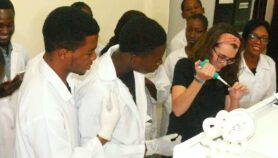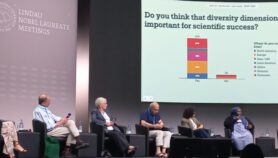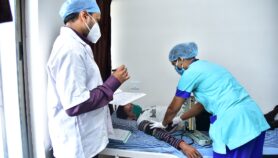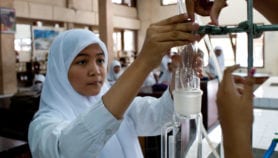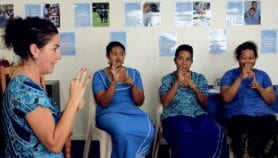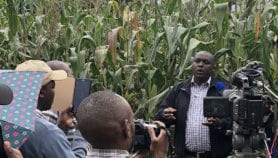By: Linda Nordling
Send to a friend
The details you provide on this page will not be used to send unsolicited email, and will not be sold to a 3rd party. See privacy policy.
Africa must use this week's science forum to adapt its innovation initiatives to fit a changing world, argues Linda Nordling.
This week an important meeting is taking place in Nairobi. Africa’s science, innovation and technology policy elite descended on the Kenyan capital on 1 April for a three-day meeting to take stock of the past decade’s failures and successes in harnessing science for the continent’s development.
Several ministers are attending the meeting, along with representatives from the continent's policy bodies, such as the African Union, and international support agencies, including the UN Educational, Scientific and Cultural Organization (UNESCO).
They will focus on what has happened since the development and adoption of the continent’s joint science and technology (S&T) plan, known as the Consolidated Plan of Action (CPA), which was approved by science ministers in 2005 and adopted by presidents two years later.
But the meeting also needs to take stock of how Africa’s position in the world has changed since the plan was written, to make sure Africa’s science push does not lose momentum and to ensure that its investment fits seamlessly into its development priorities.
A plan of its time
The CPA was a child of its time. It took shape in the first half of the 2000s, when demand from emerging economies had given commodity-rich African countries new hope. That was before the world’s richest countries sank into a financial quagmire.
In other words, it was forged at a time when Africa’s traditional development partners — the aid agencies and charitable foundations — were rather more flush than they have been lately.
Luckily, despite the financial crisis, many of the initiatives set out in the CPA have been implemented or are underway. The Southern Africa Network for Biosciences (SANBio), for example, has trained around 50 postgraduates at Masters and PhD level.
The production in 2011 of the first African Innovation Outlook, charting the science and innovation investments of 17 African countries, was another successful milestone of the CPA.
Poor coordination
But the intention of the CPA was not just to raise more resources for S&T, but also to coordinate the support flowing to the continent and make sure it matched African countries' development priorities.
Two years ago, I wrote that Africa’s science plan needed to get to grips with this latter challenge, which it has so far failed to do.
In private, aid agency officials tell me that this is still a problem. Despite the efforts of the Paris Declaration of 2005 — a roadmap intended to coordinate donors to improve the quality of aid — and its successor from last year’s meeting in Busan, South Korea, it seems that global support for science has worse coordination than other types of development support.
What makes S&T support so tricky to coordinate? Is the problem on the donor side, or on the side of the recipients? These are some of the questions that need to be addressed.
A changing world order
But the meeting also needs to take note of a changing world order in evaluating the ambitions of the CPA and the efforts it has inspired.
The global changes that have occurred over the past ten years — particularly the financial crisis, but also the rising spectre of catastrophic climate change — have moved the goalposts for Africa.
Trade within Africa was the focus of this January’s African Union presidential summit. And the global climate summit in Durban last December highlighted Africa’s vulnerability to climate change, making this a new focus area for aid flowing to the continent.
Africa’s S&T activities need to respond to these global undercurrents in order to stay relevant to development, and to keep deserving continued investment.
Africa’s first innovation prize, awarded last week, shows that policymakers are no longer content to fund labs and science — they want to reward the people who make the link between science and society by commercialising ideas and extending their reach to the real world.
This is a positive step, and there needs to be more effort to extend scientific knowledge to Africans who can put it to good use, whether they are farmers or software developers.
Looking ahead
The continent's S&T ambitions need to find a place among wider development challenges. This means joining the CPA along with other policies on trade, the environment, youth employment and agriculture.
Who should be responsible for this? It should not be left to Africa’s scientists — it would be unfair to expect them to meet the continent’s huge needs for commercialisation and extension.
Rather, governments need to make sure that policies match up — that S&T plans meet national priorities, and that people are trained who can build a bridge between the academic community, policymakers and society.
It’s good to learn lessons from the past, but this week’s gathering in Nairobi should keep an eye on the future too. It should lead to a much more cross-cutting S&T debate in Africa — and this needs to be taken to heart when policymakers return home, so they don't keep doing business as usual.
Journalist Linda Nordling, based in Cape Town, South Africa, specialises in African science policy, education and development. She was the founding editor of Research Africa and writes for SciDev.Net, Nature and others.
More on Capacity building
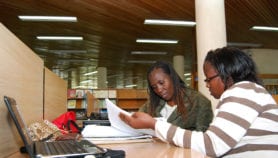
Script media release
Journalists offered ‘big break’ mentoring opportunity from Radio Nigeria
03/04/19






